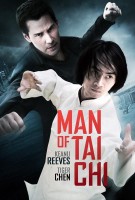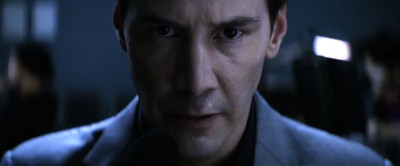February 13, 2014 Man Of Tai Chi
“Pretty good!”
I’ve been sitting here for a while now trying to think of what to say about this movie, and that’s the best I’ve come up with so far. I’m worth every penny this site pays me, folks!
You judge kung fu movies by different standards than you’d judge, say, Shakespearean movies (even if kung fu movies often use Shakespearean themes). Sure, you want a decent story and some good acting, but if those two things are top notch but the fight scenes are lousy, your kung fu movie is lousy. I’m much more forgiving of a movie that has great fight scenes but lousy acting, but only if it’s a kung fu movie. The fight scenes in Titanic weren’t awesome, but it’s still a fine movie, is what I’m saying. You don’t go to see Titanic for its fight scenes. Conversely, if you were to edit out the non-fight scenes of kung fu movies, you’d still be able to appreciate the movie if you were looking to enjoy a kung fu movie. The non-fighting scenes are pretty much there to answer the question “Why are these people fighting?” and some executive producer thought “Because they’re awesome at it!” wasn’t a good enough reason.
Man of Tai Chi introduces us to Tiger Chen, the last student of Tai Chi master Yang. Right from the beginning we see Tiger “has much to learn,” a standard opening for kung fu movies. From there we watch Tiger make choices that seem to be for the right reason, but end up being bad, but then he learns more about what his teacher meant, and then things go better. Again, this is pretty standard for kung fu movies, but “cliché” doesn’t necessarily mean “bad.”
I often feel like kung fu movies are expecting me to bring more knowledge into the viewing than I usually have. While I have learned much about Chinese culture from watching kung fu movies, I don’t have a lot to compare it to, so I don’t know how much of it I can trust. I can, of course, compare what’s presented in one movie to what’s presented in another to get a sense of what’s correct, but I’m sure that I’m missing out on things that would enhance my viewing. For instance, when you watch The Chinese Connection, you pick up pretty quickly on the animosity between the Chinese and Japanese people, but I’m sure with more knowledge of the time period that animosity would be thrown into sharper relief and make the struggle even more meaningful. However, even without that knowledge you can appreciate the student’s desire to avenge his master’s wrongful death.
Many kung fu films are designed to show the strengths of a particular style. One of the threads of this movie is about how people are surprised to see a practitioner of Tai Chi competing and winning. The sense is given that it’s not usually used in this way, so wiki’d myself into some more knowledge on the subject:
The philosophy of t’ai chi ch’uan is that, if one uses hardness to resist violent force, then both sides are certainly to be injured at least to some degree. Such injury, according to t’ai chi ch’uan theory, is a natural consequence of meeting brute force with brute force. Instead, students are taught not to directly fight or resist an incoming force, but to meet it in softness and follow its motion while remaining in physical contact until the incoming force of attack exhausts itself or can be safely redirected, meeting yang with yin. When done correctly, this yin/yang or yang/yin balance in combat, or in a broader philosophical sense, is a primary goal of t’ai chi ch’uan training. Lao Tzu provided the archetype for this in the Tao Te Ching when he wrote, “The soft and the pliable will defeat the hard and strong.”
Traditional schools also emphasize that one is expected to show wude (“martial virtue/heroism”), to protect the defenseless, and show mercy to one’s opponents.
This description of the Tai Chi philosophy really does help my appreciation for the film. Some moments in the film make more sense to me now, and it gives a deeper meaning to the film as a whole. There is a lot of talk about which path Tiger will choose, and at one point he is literally standing on a yin-yang symbol as he studies.
That student/teacher relationship is one of the most powerful in kung fu movies. Very often when a student doesn’t heed his master’s teaching, he comes to a) realize his mistake, or b) a bad end. Much is made of the history of martial arts, and the teacher-student relationship is the way that history continues, so it becomes sacred, in a way. You don’t want to be the last link in a 400-year-old chain. When Tiger realizes what his teacher was trying to get him to understand and uses that knowledge to defeat evil, it’s not surprising, but it’s still cathartic.
This is Keanu Reeves’ directorial debut. You can tell he’s a fan of kung fu movies, as the fights are filmed so you can actually see them. It’s a “this style vs. that style” movie, which is another popular theme in these sorts of films. It’s a theme I’m a complete sucker for, and it’s most likely linked to the same part of my brain that enjoys “Who would win in a fight between Optimus Prime and Voltron?” type questions (answer: Optimus Prime, duh.). There are rough bits here and there, but as I mentioned at the outset, the overall movie was “pretty good!” Keanu plays the villain/catalyst and it’s role I can see him playing more often. He gives off a sinister and calculated vibe, and it’s the first time in a while he’s seemed older to me. I saw 47 Ronin not too long ago and still kind of felt like Keanu was the same age he’d been for a long time. His agedness works well here, and it’s used in his fighting style – he’s more straightforward and brutal, rather than showy and fluid. I hope he makes more kung fu movies, right after Bill & Ted 3 finishes up.
Tags: kung fu
Written by: Mark
- Leave a comment
- Posted under Movies


Leave a Reply